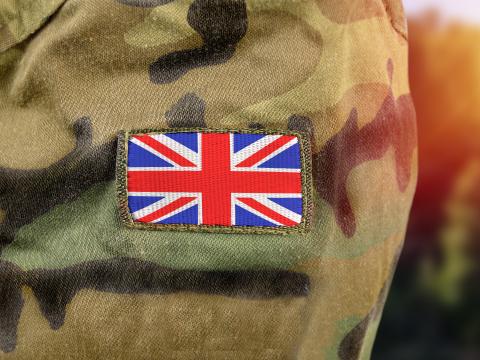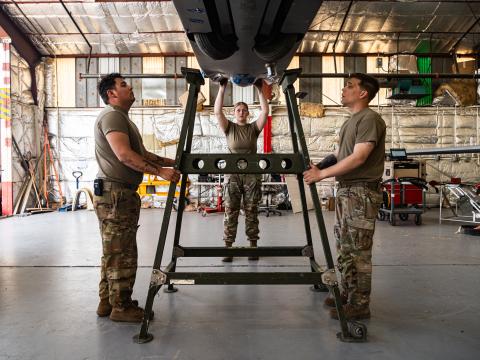Advanced Capabilities Required for Future Navy Warfighting
Future conflicts likely will be fought in degraded information technology environments, which will require the U.S. Navy to develop and exploit new capabilities to continue to operate in contested cyberspace. Technologies such as a flexible information grid, assured timing services and directed energy weapons must be part of the naval information system arsenal if the sea service is to maintain information dominance through the year 2028.
These were just a few of the findings presented in the Navy’s Information Dominance Roadmap 2013-2028, which was released in late March. Presented by Rear Adm. William E. Leigher, USN, the Navy’s director of warfighter integration, the report outlines the growing challenges facing the fleet and how the Navy must meet them.
The report divides information dominance challenges into three areas: assured command and control (C2), battlespace awareness and integrated fires. While the United States will continue to maintain supremacy in those areas, that supremacy is shrinking as more nations are closing the gap between U.S. capabilities and the ability to disrupt them.
Among the advanced capabilities the Navy will require toward the end of the next decade is assured electromagnetic spectrum access. Achieving this will entail fielding greater numbers of advanced line-of-sight communication systems; being able to monitor combat system operational status and adjust it using automated services; having a real-time spectrum operations capability that enables dynamic monitoring and control of spectrum emissions; and generating a common operational picture of the spectrum that is linked to electronic navigation charts and displays operational restrictions.
A dynamic flexible grid that can connect every node will be needed so that information assets can rely on more than space assets to remain networked. This dynamic grid would sense and react to changes in the operational environment, rerouting traffic as needed.
Having mission-relevant data for shared awareness would permit operators to extract vital data rapidly across the range of naval information. This in turn will require a more advanced data-centric architecture that would allow key systems to report their operational status automatically.
Given that many existing and emerging capabilities threaten to degrade or deny Global Positioning System (GPS) data, the Navy will need alternative methods of providing assured timing services. These might include enhanced redundancy and protection for GPS and other space-based communications as well as a low-frequency navigation system, such as Loran, for time and frequency synchronization.
For battlespace awareness, the Navy will require improved strategic/operational/tactical sensor coordination and collaboration; integrated intelligence and operational information; better data and information access and sharing; and advanced information fusion, analysis, dissemination, management and relay. Achieving these goals will require several technology improvements.
Sensor development must be advanced across all domains, with enhanced autonomy in all elements to reduce data latency. The mix of autonomous manned and unmanned platforms and sensors would be optimized to include multi-INT, multidomain collection capabilities. Space assets would be changed significantly, as larger single-capability satellites would be replaced by other types of platforms hosting sensor payloads. These platforms might include micro-, mini- and even nano-satellites. Power use would be optimized by developing low-power sensors and better batteries and fuel cells.
To provide better insight into an adversary’s intentions and actions, the Navy will need better electromagnetic spectrum and weather analysis and prediction. Cloud computing will play a major role providing afloat and ashore users with enhanced collaboration as well as uninterrupted access to advanced online analytical tools and databases. A related element is extensive reach back for understanding the capabilities of allies, adversaries and neutrals. This includes electromagnetic battle management assessments and force status.
The third area, integrated fires, mandates “a coordinated effort across multiple Navy and joint organizations” to begin development of a Navy integrated fires family of systems approach, the report states. New systems such as directed energy weapons and offensive cyberspace operations must be incorporated into conventional operations so the Navy has more focused lethal and nonlethal effects.
This new integrated capability would serve to prevent an adversary from initiating kinetic and nonkinetic operations, the report notes. Many of the nonkinetic activities would be similar to those an enemy would employ against U.S. forces, such as cyber and C2 denial. Both kinetic and nonkinetic means would be directed to denying an adversary the ability to use its most advanced weapons against allied forces. A goal would be to reduce the need for allied forces to rely on high-risk conventional operations.
Weapons would be network-enabled with more autonomous weapons that share sensor data beyond that of traditional intelligence, surveillance and reconnaissance missions. Long-range directed energy and electromagnetic-driven weapons would be part of the fires, and cross-domain targeting applications would exploit fused multi-INT data.
And, while the Navy is hard at work ensuring spectrum access for its own assets, it also would exploit spectrum as a weapon. Electromagnetic maneuver warfare would be elevated to a primary element of warfighting. Both directed energy weapons and cyber would serve as nonkinetic fires capable of lethal effects.
The full roadmap is available at www.public.navy.mil/fcc-c10f/Strategies/Information_Dominance_Roadmap_March_2013.pdf




Comments